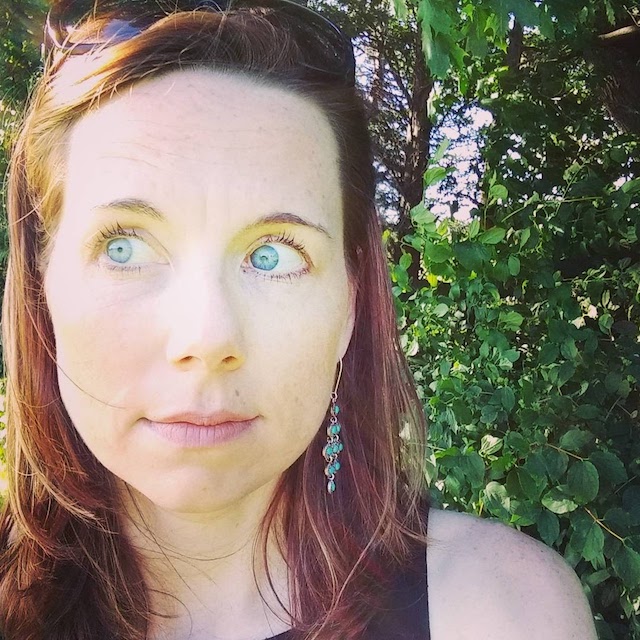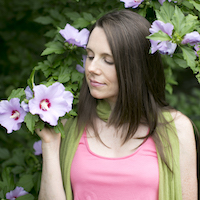
I’m going to share a shameful truth with you.
I had a selfie photoshoot to post a picture on my Instagram to go with something I’d written. I hated all the pictures. I started searching for a filter to doctor up the most “acceptable” one—until I stopped myself.
It didn’t feel right.
What was I trying to cover up? What was I hiding? And what did I want to project to the world by hiding it?
I finally posted a picture I thought showed some of my “facial flaws,” which I thought would be a more authentic representation than some glammed-out, highly-filtered shot. I actually had to take a deep breath when I posted it, which made me feel sad. I felt sad for myself and for all of the people who feel like they can only show the social media world (and the world at large) the prettiest, best, and most perfect version of themselves.
This shame made me realize how much I give my power away with the filters I put on, not just my selfies, but my life.
What is beauty, anyway?
Is it in my wise wrinkles, showing my natural age, or in hyper-moisturized under-eyes?
Is it in perfectly-colored hair, or in those little gray root hairs?
Is it straight white teeth, or carefree crooked ones?
Is it cellulite or toned runners thighs?
Is it love-handles or tight abs?
Painted toenails or dirty bare feet?
Is it all of these or none of these?
Perhaps the “either or” mentality is part of the endless quandary of what it means to be beautiful.
I used to aspire to look a certain way not to please myself, but to please others. The uncomfortable truth is that most people are, in fact, trying to please me—and same for you!
We adults get up not to “play” and find joy in our day—but to perform for an audience we hope will applaud our end-of-day exhaustion.
The truth?
People are too busy looking at their own Instagram and Facebook likes to even really notice us.
We use filters not only in our cameras, but in our minds and hearts. What are we filtering out? Truth? Authenticity? If we dig deep, we will see the answer to this may just be “yes.”
It’s a scary answer to uncover, not just because it removes our masks, but because it requires us to do the work to live a joyous, untethered, and playful life without that candy-coated facade. It requires us to stop giving a f*ck about “others” because the sticky, wet, uncomfortable, and perhaps very plain truth is that most people are too involved with themselves to care about our facades. They are too busy to care about anyone else because they are creating their own masks to impress us with.
What does it mean to look at ourselves without a filter?
What does it mean to sit with our instinctual cringing as our finger hovers over the beauty-face filter, ready to erase those under-eye wrinkles. What if we don’t press it? Not only on our cameras, but in our minds? What if we start looking at ourselves without filters and start to be real.
We start to appreciate the years of living that earned us those marks of wisdom and kisses by the sun. We start to see that not forcing a smile means that we sometimes feel pain, sadness, discomfort, and seriousness. As we remove the filters from our physical perception of ourselves, we open up to an array of emotion and thoughts about who we are. Through that real-self lens we embrace a sense of power—discovering the true source of what it means to be beautiful.
Embracing who we are—every line, curve, bit of cellulite, and pimple takes courage.
Being with yourself in your imperfectness takes power. Unfortunately, Hollywood and the advertising industry promote a standard for filtered images that mostly negate the call to embrace true, authentic beauty.
For example, I love Audrey Hepburn. I grew up idolizing her beauty. In my teen years, I had photos of her plastered to my wall. I would often look at my neck and compare it to hers. My neck—it would never in a million diets be as long and lean as hers. But I didn’t know Audrey. And what I admired was merely her filtered black and white images. I admired a one-dimensional character.
So many of us, at some point in our lives, long to be or look like someone we have never met or may never truly know. We don’t know what their morning bedhead looks like. We don’t know who they are without the hot lights and fancy makeup showcasing their best angles. We don’t know what their heart longs for or what they value. We don’t know their true beauty—what makes them authentically human.
Most of us live life running from our authentic self. Most of us run and try and emulate those we’re running with for a time, until we desire to emulate something or someone different. I gave up on Audrey. I realized how plastic she was in my mind, and how my ideal image of her was just that—an image of perfection that black and white photos seemed to make me think was an attainable state.
We won’t know beauty until we stop running. And stopping means we have to see what someone else told us was ugly with our own eyes—in our own light. We see it and we define what it means to us—for us. From that place, we see what is real. From that place we accept true beauty and, only then, can we begin to see it all around us.
I learned this lesson when I met a close friend who is a portrait artist and sculptor. When I finished my undergraduate degree, I went to visit her in Florence and spent two weeks roaming around Europe with her. As we roamed Italy, I ogled every chiseled body sculpture. I listened to her comment, not only on the art, but on the people she saw. She had just spent months looking at nude models for her sculpture class. Every curve and bit of cellulite—every line and wrinkle—was seen by her as art.
Through her commentary, I gained a new perception of the human body. For my friend, the perfect body was an anomaly. She almost seemed to crave the imperfection. She would try and replicate what she saw—in her drawings and her sculpting. Replication of imperfection was true perfection. Why? Because she knew the object of her artistic attention was already perfection from the start—the perfection of being seen.
Unfortunately, with the filter-hungry social media culture we live in, maintaining this view takes constant nurturing. I am no longer in touch with my artist friend, but she left a resonance in my beauty-hungry heart. She left me with the courage to see what others may not yet understand. The beauty we seek— it’s there in the imperfections. The beauty is the imperfection.
With each unfiltered photo we post, we become a magnet. We become magnetic because we feel empowered— and that bleeds out to onlookers. Suddenly our friends and family may feel comfortable enough taking their filters away too. We’ll see each other for who we truly are—and then we find the meaning of the word “beautiful.”
P.S. My hope for you, dear reader, is that you too can share your authenticity—in images, in words, in physical forms, in your waves of emotion—in your authentic you-ness! With each social share, know that you are encouraging others to do the same. Know that each time you are brave enough to skip the filters, it doesn’t matter who likes your post. When you post without filters, your like is the only one you need.
This is true beauty. That post is perfection. And the others? They will get it—eventually.
~
~
~
Author: Sarah Lamb
Image: Author’s own
Editor: Danielle Beutell
Copy Editor: Travis May
Social Editor: Travis May
 Share on bsky
Share on bsky





Read 0 comments and reply